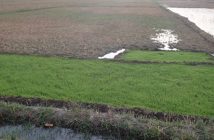Veterans and their dependents have proven to be one of the fastest-growing populations at Fordham. The number of veterans and their dependents grew from 180 a year ago to 236 this fall.
“It’s something that Fordham has distinguished itself in, not just this time around, but after Vietnam and after World War II—after every conflict going back to the Civil War,” said Michael Gillan, Ph.D., associate vice president at the Lincoln Center campus and co-chair of the FordhamVets Task Group.
The number of veterans has risen steadily since Fordham launched the Fordham University Veterans Initiative (FordhamVets) in 2009, which offers services geared toward helping veterans move from the military to college life.
Several new initiatives are enhancing the University’s veteran-friendly reputation. This semester, the Human Resiliency Institute in the Graduate School of Education implemented Edge4Vets, a pilot program that involves workshops that help veterans transition into student life and, ultimately, a career.
“They come from the military with very strong core beliefs around duty, dependability, integrity and more. And those provide a solid foundation in civilian life,” said Tom Murphy, director of the Human Resiliency Institute. “Edge4Vets seeks to help them translate those beliefs into application for civilian use.”
Ultimately, Murphy said, the program—which will hold its final workshop on Jan. 18—will expand to include a business mentorship in one of 200 organizations nationally for all participating veterans.
Another contributing factor to the growing number of veterans seems to be communication among the veterans themselves, Gillan said. In particular, a new student group—Armed Forces at Fordham—helps disseminate information to current and prospective student veterans.
“More than anything else, it’s good word of mouth,” Gillan said. “They’re happy and they’re doing well and that gets communicated in various ways.”
In addition, Gillan said, Fordham’s leap from No. 55 to No. 34 in Military Times EDGE magazine’snational list of the top 100 “veteran friendly” colleges and universities has increased interest in the University.
“We’re beginning to see some increased interest in inquiries because of the fact that we jumped in the rankings,” Gillan said. “We’re the highest-ranking school in New York City.”
Marco Bongioanni, a GSE student who served two tours with the Army in Iraq, said Fordham’s participation in the Yellow Ribbon Program helped guide his decision to apply.
“I was doing research about the GI Bill and saw that Fordham was a Yellow Ribbon school, so that was a motivating factor to make sure I could maximize my benefits,” he said.
Colleges and universities in the Yellow Ribbon Program can voluntarily fund up to 50 percent of tuition and fees not covered by the basic $17,500 included in the Post-9/11 GI Bill. The Department of Veterans Affairs then matches the school’s contribution.
Fordham contributes the maximum amount—50 percent—and also does not cap the number of veterans who can benefit from this program.
“[Fordham has been] very active from day one,” Bongioanni said. “Very positive, very proactive. And it’s increased since I’ve been here. There are even more activities and programs that the administration has begun that show how much they support veterans.”
“What a typical student veteran is looking for is institutional commitment—a financial one, and Fordham’s participation in the Yellow Ribbon Program speaks directly to that,” Gillan said.
But even more than financial commitment, students are looking for a school that will support their overall well-being—something that Gillan said a Jesuit institution can accomplish.
“Jesuit schools have the capability of doing better than most because of that great tradition that infuses everything in a Jesuit school, namely the term cura personalis,” he said. “That real care for the person expressed in many, many ways—in the classroom, out of the classroom—that is extremely important to all students.
“It’s particularly valuable to men and women who have served and need a little extra in that regard to transition from desert to desk. And you see it. You see it every day.”


